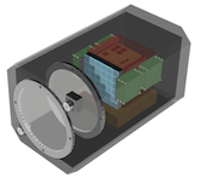Test procedure¶
General guidelines for tests concerning the Mini-EUSO instrument.
Initial set-up¶
Check all sub-systems are connected correctly and that the grounding is proper
Document the state of the instrument (preferably with pictures)
Keep a log of tests carried out in addition to the log files provided by the CPU, although these should also be saved (there is a section dedicated to integration and testing on the Mini-EUSO wiki)
Before starting tests run
mecontrol -help, this callsInputParser::PrintHelpMsg()function to see all available commandsRead the usage documentation pages to understand the operation of the instrument and what these commands do
Start by running
mecontrol -dbto run a debug program of the main subsystems and check everything is working as expected, this calls theRunInstrument::DebugMode()functionMake sure to use the
mecontrol -comment "..."command to add a comment to both the filename and theCpuFileHeader
Connecting to Zynq¶
The
mecontrolsoftware automatically switches on the Zynq and waits for it to boot when performing an acquisition. However, in the past there have been some issues which require a Zynq reboot, for which the commandsmecontrol -lvps off -subsystem zynqandmecontrol -lvps on -subsystem zynqcan be usedIf there are problems with the automatic connection of the Zynq by the
mecontrolsoftware, try rebooting the Zynq and checking forping 192.168.7.10to return with 0% packet loss before trying themecontrolsoftware again.
Tests with HV¶
Always take care when using the HV that the instrument is in proper darkness (black box) and that all LEDs are disabled or removed
Once satisfied that the grounding is correct and the instrument is in proper darkness, start by switching the HV on to < 300 V using, for example,
mecontrol -hvswitch on -hv all -dv 1000to ramp up the HV dynode voltage. The cathode voltage is always set to the 900 V mode (other modes are 0 V and 750 V). This is done withZynqManager::HvpsTurnOn().The status can be further checked using the
mecontrol -check_statuscommand (RunInstrument::CheckStatus())The HVPS status returns 9 numbers, corresponding to each EC unit:
0: the EC unit is off
1: the EC unit is on, but status is undefined (can be switched down)
2: the EC unit is on, but not at the correct voltage (switched down)
3: the EC unit is switched on and at the correct voltage
For the engineering model, only one EC is connected and thus the unconnected ECs will return undefined results
When the HV is behaving as expected with simple status checks, it is suitable to proceed with raising the HV dynode voltage to the desired level
To take an acquisition with the HV on use, for example:
mecontrol -log -hv all -dv 3000 -asicdac 500 -zynq periodic
The asic dac must be set when taking an acquisition, otherwise, the value in the configuration file will be used by default
This is the ASIC threshold setting, and should correspond to the single photoelectron plateau of the S-curve
To take an S-curve with the HV on run:
mecontrol -log -hv all -dv 3000 -scurve
There is no need to specify the asicdac for an S-curve, all thresholds will be scanned
Ensure the HV is switched off before exposing the instrument to high light levels by checking that the
mecontrol -check_statusreturns:HVPS status: 0 0 0 0 0 0 0 0 0
NB: If EC units are not connected, their status will be undefined and can return non-zero values. In this case use the EC by EC commands described here.
